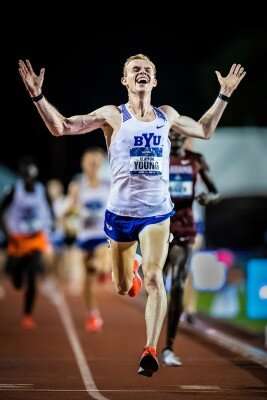Can your shoes really make you run faster?

Led by Professor Iain Hunter, researchers at BYU studied top marathon running shoes to discover if one could help runners be more efficient
In 2017, Nike released a running shoe with the intent to make marathon runners markedly faster. Led by Professor Iain Hunter, researchers at BYU decided to test if those claims were true.
After conducting tests, the team did find that the benefit offered by the Nike Vaporfly 4% shoes was enough to reduce the energy cost of running by 2.8 percent on average compared to other popular running shoes which could ultimately improve a race time by several minutes.
"The Vaporfly 4% shoe has the ability to allow runners to use less energy when they run," Hunter said. "It especially seems to help those who spend less time on the ground than those who spend greater time on the ground when running."
The study, which was published online in the Journal of Sport Sciences , compared the Nike Vaporfly 4% with the Adidas Adios Boost and the Nike Zoom Streak, two of the most popular shoes for elite marathon runners.
To measure the effectiveness of the shoes, nineteen men participated in two days of testing. To qualify, each of the men had to have completed a 10km run in less than 32 minutes within the past year. Subjects completed five-minute runs at 6:00 minutes per mile pace on an instrumented treadmill followed by five minute-breaks to change shoes until they had worn all three shoe models twice.
"We added in a few measurements from a force-sensing treadmill so we could begin to understand what is making the shoe effective and how people move differently when they wear the Vaporfly 4%," Hunter said.
The treadmill measures three-dimensional force as someone is running on it. It captures information such as how long the runner is on the ground, how much he or she is pushing backwards and forwards on each step, where the foot hits the ground, how much force the foot is applying and the length of the runner's stride.
"Muscles contract to aide tendons in absorbing and returning energy," Hunter said. "If the sole of an energy efficient shoe can contribute to this instead, less muscle work is required, which improves running economy."
The data showed significant differences in the oxygen uptake (a way to measure the energy cost of running) in the Vaporfly shoe resulting in a 2.8 percent improved running economy, or the amount of energy it takes a runner to go a certain distance, over the Adidas shoe on average. Many physiological, anatomical, biomechanical, and external factors affect running economy. Since it is such a large component of endurance performance, even a small change in oxygen uptake is likely meaningful to a runner and can add up over the course of 26 miles.
Additionally, the Nike Vaporfly 4% shoe led to an average of increased stride length of two centimeters, partially due to its higher heel height. Even small changes such as a two-centimeter change in stride length means putting someone more than 200 meters further ahead through the distance of a marathon.
More information: Iain Hunter et al. Running economy, mechanics, and marathon racing shoes, Journal of Sports Sciences (2019). DOI: 10.1080/02640414.2019.1633837
Provided by Brigham Young University














